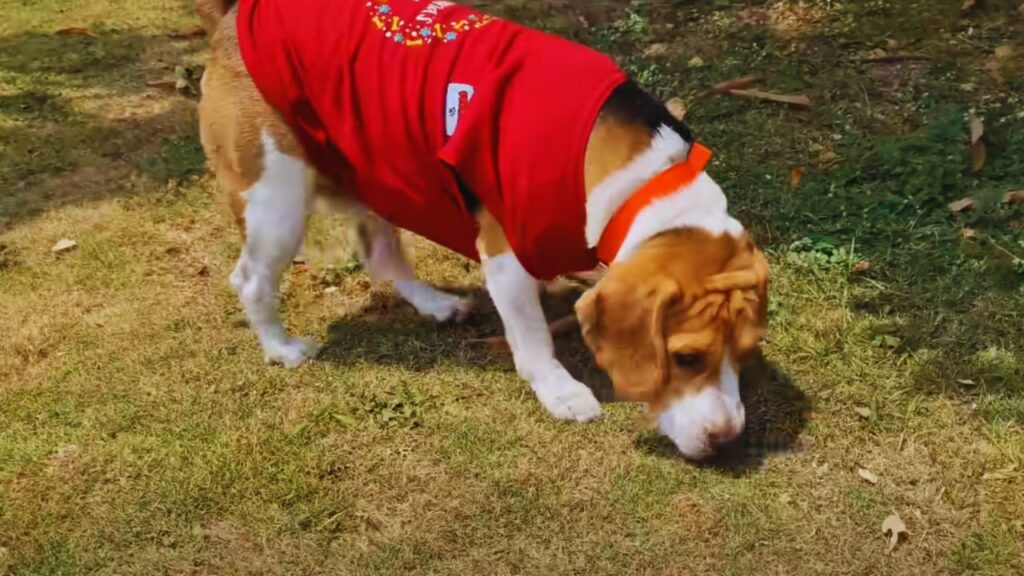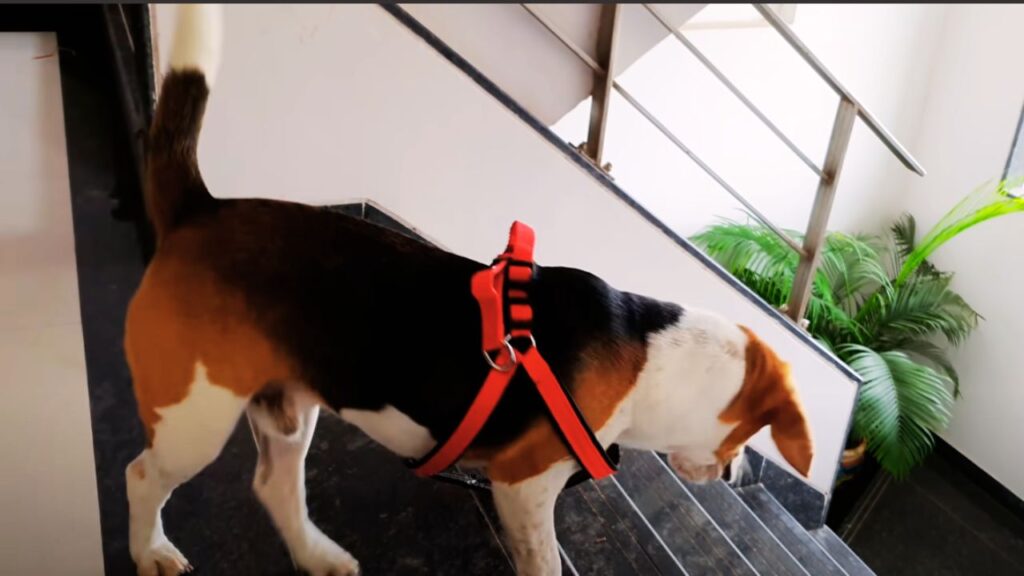When deciding between a collar or harness for your Beagle, it’s important to understand that both options have their advantages and disadvantages. Beagles, as a breed, are known for their strong sense of smell, high energy, and tendency to pull on the leash while walking.

These factors can help guide your decision on whether to use a collar or a harness. So, Is a collar or harness better for a beagle? Here’s an in-depth comparison to help you decide what’s best for your Beagle. Discover the best collars for short-haired dogs with these 6 top recommendations.
Blog Highlights
ToggleBeagle’s Characteristics
Beagles are highly active and curious dogs with a strong prey drive. Their keen sense of smell often leads them to pull on the leash as they chase scents, which can make walks challenging if you’re not using the right equipment. They also have a relatively short and muscular neck, which is worth considering when choosing between a collar and harness.

Is a Collar or Harness Better for a Beagle?
Is a collar or harness better for a beagle? A harness is generally better for a Beagle, especially for walks, as it provides more control, reduces pulling, and prevents neck injuries. Collars, however, are essential for holding identification tags and can be used for trained dogs during calm walks. Use both for optimal safety and comfort. Understand if the Cane Corso is a high-maintenance dog with this insightful guide.

Collars: Pros and Cons for Beagles
Pros of Using a Collar:
- Identification and Tags: A collar is essential for holding identification tags, which can be lifesaving if your Beagle gets lost. It’s a visual cue that the dog has an owner, helping people quickly identify a lost dog.
- Convenience: Collars are easy to put on and take off, making them a convenient option for daily wear.
- Leash Attachment for Trained Dogs: For Beagles that are well-trained and don’t pull on the leash, a collar can be sufficient for walking. Collars allow for more direct control, which can be useful for short, calm walks.
Cons of Using a Collar:
- Risk of Neck Injury: Beagles are notorious for pulling on the leash, especially when they catch an intriguing scent. When using a collar, this pulling can place significant pressure on their neck, leading to potential injuries. The neck houses delicate structures such as the trachea, thyroid gland, and cervical vertebrae, which can be harmed by excessive pulling. Beagles, being tenacious, may ignore the discomfort, but over time, consistent pressure can cause long-term damage.
- Difficulty in Controlling Strong Pullers: A collar doesn’t provide the same level of control as a harness. If your Beagle tends to pull strongly, a collar might not be effective in managing their strength, leading to frustration and potential escapes. Explore the Cane Corso growth and weight chart and nutrition plans.
Harnesses: Pros and Cons for Beagles
Pros of Using a Harness:
- Better Control: Harnesses distribute the pulling force across a larger area of your dog’s body, primarily the chest and back, which makes it easier to control a Beagle’s pulling behavior. This reduces the strain on the neck and minimizes the risk of injury.
- Ideal for Active Dogs: Beagles are adventurous and often get distracted by scents. A harness gives you better control over their movements, helping to prevent them from running off unexpectedly or pulling too hard in the wrong direction. It also makes leash training easier for young or overly excited Beagles.
- Safer for Dogs with Respiratory Issues: Since Beagles are prone to neck injuries, harnesses are a safer option, especially if your dog has any respiratory issues. By avoiding pressure on the neck, a harness can make breathing easier during vigorous walks.
- Prevents Slipping: Some dogs are adept at slipping out of their collars. A well-fitted harness, particularly a three-point harness, can prevent escape attempts, which is especially useful for a determined breed like the Beagle.
Cons of Using a Harness:
- Can Be Uncomfortable if Poorly Fitted: A harness must be fitted properly to avoid causing discomfort or restricting movement. If the harness is too tight or too loose, it may rub against the skin, causing irritation, or hinder your Beagle’s natural gait.
- Can Encourage Pulling if Not Used Correctly: While harnesses provide better control, they can sometimes encourage pulling behavior if the dog is not trained properly. Beagles may feel that pulling forward gives them more freedom to explore if the harness isn’t paired with proper leash training.
- More Complicated to Put On: Unlike a collar, harnesses can be more complicated to put on, especially if your Beagle is excitable or impatient. Dogs that aren’t used to harnesses may resist initially. Find out the best collars for Cane Corsos to suit their unique needs.
Comparison Table: Harness Vs Collar For Beagles
Here is a simple comparison table for Harness vs. Collar for Beagles:
The Case for Both: When to Use a Collar and When to Use a Harness
For many Beagle owners, using both a collar and a harness is the best solution. Here’s how you can decide when to use each:

- Collar for Identification: Even if you opt for a harness during walks, always have your Beagle wear a collar with identification tags. Beagles are known for their curiosity and can sometimes slip away from you during walks or outdoor play. Having a collar with ID tags ensures that your dog can be quickly identified and returned if they get lost.
- Harness for Walks and Training: Use a harness for outdoor walks, especially if your Beagle is a strong puller or still learning leash manners. Harnesses offer better control and reduce the risk of injury during pulling. They also help distribute pressure across the body, preventing neck strain.
- Collar for Short Walks and Calm Dogs: If your Beagle is calm, well-trained, and doesn’t pull much on the leash, a collar may suffice for short walks. However, if you notice your Beagle pulling, consider switching back to a harness for their safety and your peace of mind.
Choosing the Right Harness for Your Beagle
There are many types of harnesses available, so selecting the right one for your Beagle is essential. Here are a few tips to consider when buying a harness:
- Look for a Front-Clip Harness: For Beagles that tend to pull, a front-clip harness is a great option. The leash attaches at the front of the chest, so when your dog pulls, it naturally redirects them back toward you, discouraging the forward motion. This design makes it easier to train your dog to walk calmly on a leash.
- Ensure a Proper Fit: It’s important that the harness fits snugly but comfortably. If it’s too loose, your Beagle might slip out; if it’s too tight, it could rub and cause chafing. Always measure your dog’s chest and neck to ensure the right fit and adjust the straps as necessary. Harnesses that are too restrictive can limit your Beagle’s range of movement, particularly around the shoulders, which could cause discomfort over time.
- Consider Padding for Comfort: Look for harnesses that have soft padding, especially if your Beagle is prone to pulling. Padding helps prevent irritation, especially in high-friction areas such as under the armpits or around the chest.
- Durability for Active Dogs: Beagles are known for their high energy and adventurous spirit, so opt for a harness made from durable materials. Reinforced stitching and high-quality clips are essential for preventing wear and tear, especially if your Beagle pulls or is particularly strong. Learn how to put a collar on a Husky with these practical tips.
Training Tips for Using a Harness with Your Beagle
- Introduce the Harness Gradually: Some Beagles may be resistant to wearing a harness at first. Introduce it gradually by letting your dog wear it indoors for short periods, using treats and positive reinforcement to build a positive association. This will help your Beagle get accustomed to the harness without resistance.
- Leash Training: Even with a harness, it’s essential to train your Beagle not to pull on the leash. Reward calm walking and use commands like “heel” to encourage your dog to walk beside you instead of pulling ahead.
- Practice in Low-Stimulation Areas: Start leash training in areas with fewer distractions before taking your Beagle on more stimulating walks where their prey drive might be triggered. Gradual exposure will help them learn to walk calmly, even in high-energy environments.
Types of Collars and When to Use Them
While a harness is often the better choice for walking your Beagle, there are still circumstances where a collar is useful. Here are some different types of collars and their potential benefits:

- Flat-Buckle Collars: These are the most common types of collars, used primarily for holding identification tags. They are ideal for everyday wear, but not necessarily for walking, especially if your Beagle pulls.
- Martingale Collars: For Beagles that are prone to slipping out of traditional collars, a martingale collar can be a safer option. This collar tightens slightly when the dog pulls but doesn’t choke. It’s an excellent option for Beagles with narrow heads compared to their necks.
- Rolled Collars: If your Beagle has sensitive skin or is prone to neck irritation, a rolled collar may be more comfortable. These collars reduce the risk of fur matting and skin irritation.
Wrapping Up!
In conclusion, choosing between a collar and a harness for your Beagle largely depends on your specific needs and your dog’s behavior. A harness is typically the better option for walking and training as it provides more control and reduces the risk of neck injuries.
However, a collar is essential for everyday wear to hold identification tags and can be used for calm, well-trained Beagles. Ideally, using both—a collar for identification and a harness for walks—ensures your Beagle’s safety, comfort, and well-being. Hope so, now you know the answer: Is a collar or harness better for a beagle? Discover the best collars for Siberian Huskies for both style and comfort.





